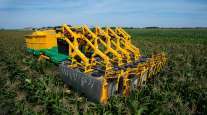Competition Heats Up for Lidar Sensors in Autonomous Sector

As the race to create robot cars intensifies, a secondary race is underway: a high-stakes competition to develop the sensors that serve as the cars’ “eyes.”
Lidar, a light-sensing form of radar, provides vision for the vast majority of autonomous vehicles being developed, but now there are dozens of companies with different twists on it.
Baraja, based in Australia and San Francisco, is the latest entrant. After 2½ years in stealth mode, the startup is unveiling its Spectrum-Scan Lidar, which it says uses prism-like elements to achieve maximum flexibility, reliability and clarity.

In our debut episode of RoadSigns, we ask: What does the move toward autonomy mean for the truck driver? Hear a snippet from Alex Rodrigues, CEO of Embark, above, and get the full program by going to RoadSigns.TTNews.com.
“We give the car’s computer full control to change the [viewing] resolution on the fly to adapt to different road conditions,” CEO and co-founder Federico Collarte said. “We can change the focus of attention just as a human driver changes gaze — close-up for city driving and farther away for highways.”
Most lidar sensors rotate to capture a 360-degree view, which is why they are compared with spinning KFC buckets. Baraja’s lidar is stationary, so a car would need four of the sensors for full coverage. The company said its approach increases reliability, reducing the chance that delicate moving parts will fail due to constant vibration.
Lidar bounces laser waves off objects and calculates their distance based on how long it takes the waves to return. The Spectrum-Scan Lidar can shoot out different colors of light, which the company said provides an unlimited number of ways to calculate that distance.
“Baraja,” which is Spanish for deck of cards or shuffling a deck of cards, alludes to the sensors’ ability to “shuffle” light, Collarte said.
Another innovation is that the sensor’s “brain,” an engine that processes its data, is housed separately inside the car, where it is better protected from potential damage. Each engine can handle four sensor heads, connected to it by fiber-optic cable.
Baraja’s sensor can see dark objects 650 feet away, the company said. Portola Valley’s Luminar Technologies makes the same claim about its lidar sensor, which, similar to Baraja’s, does not spin.
Other companies working on lidar include the industry leader, Velodyne Lidar of Morgan Hill, which has a San Jose “megafactory” that it says can crank out a million sensors a year. Sunnyvale’s Quanergy Systems offers lidar for robot cars and other functions. Some prominent startups include San Francisco’s Ouster, and Pleasanton’s AEye. Some companies developing robot cars are creating their own lidar, notably Waymo, the self-driving division of Alphabet, and General Motors’ Cruise division.
As robot cars become a worldwide reality — expected to start happening within the next two years — the lidar market should grow, hitting $2.5 billion by 2026, according to IHS Markit.
The 60-person Baraja expects to grow to 100 employees by year end. It is funded by the likes of venture firms Sequoia China and Blackbird, but the firm declined to say how much backing it has. The company said it has been working with major automakers but would not identify them.
Baraja said its lidar would be competitively priced without revealing the cost. It uses off-the-shelf telecom and automotive components, Collarte said, which should enable mass production and a low-cost supply chain.
Distributed by Tribune Content Agency, LLC




